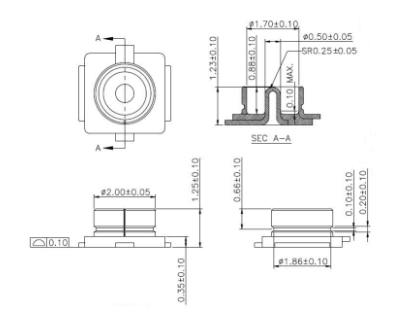ZS13S Module Datasheet
Last Updated on : 2025-04-01 03:22:48download
ZS13S is a Zigbee module that Tuya has developed. It consists of a highly integrated wireless RF processor chip (EFR32MG21A020F768IM32-B), a few peripherals, a built-in 802.15.4 PHY/MAC Zigbee network protocol stack, and rich library functions.
Product overview
ZS13S is embedded with a low-power 32-bit ARM Cortex-M33 core, 768-KB flash program memory, 64-KB RAM, and rich peripherals.
ZS13S integrates all function libraries of the Zigbee MAC. You can develop embedded Zigbee products as required.
Features
- Embedded ARM Cortex-M 33 processor having a low-power 32-bit CPU and having DSP instructions and Be pulled uping-point units can also function as an application processor
- Maximum clock rate: 80 MHz
- Wide operating voltage: 2.0 to 3.8 V
- Peripherals: 17 GPIOs, 1 universal asynchronous receiver/transmitter (UART), 1 analog-to-digital converter (ADC), and 1xnRST
- Zigbee connectivity
- Support 802.15.4 MAC/PHY
- Working channels 11 to 26@2.400-2.483 Ghz Air interface rate: 250 Kbps
- Up to +20 dBm output power
- 60μA/MHz running power consumption; 5 μA sleep current
- Copper pillar antenna/a reserved Ipex connector can be used with an external antenna with a high gain
- Operating temperature: -20 to 85℃
- Support hardware encryption and AES 128/256
Applications
- Intelligent building
- Smart household and home appliances
- Smart socket and light
- Industrial wireless control
- Baby monitor
- Network camera
- Intelligent bus
Module interfaces
Dimensions and footprint
-
ZS13S has three rows of pins with a 1.27 mm pin spacing.
-
The ZS13S dimensions are 15±0.35 mm (W)×18±0.35 mm (L) ×2±0.15 mm (H). The size of a pad of a single pin is 1.5 mm*0.7 mm. The dimensions of ZS13S are as follows:
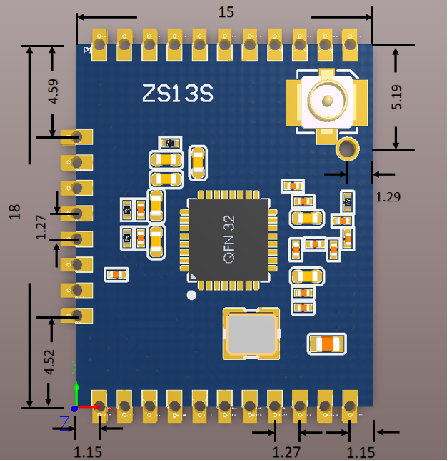
Pin definition
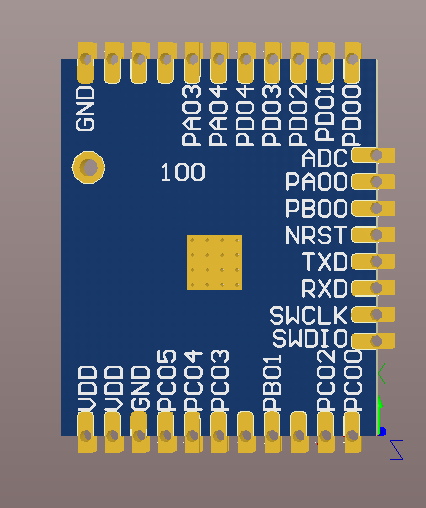
| Pin number | Symbol | I/O type | Function |
|---|---|---|---|
| 1 | GND | P | The reference ground of the module |
| 2 | NC | / | Be pulled up |
| 3 | NC | / | Be pulled up |
| 4 | NC | / | Be pulled up |
| 5 | PA 03 | I/O | Function as a GPIO and correspond to PA 03 (pin 20) of IC |
| 6 | PA 04 | I/O | Function as a GPIO and correspond to PA 04 (pin 21) of IC |
| 7 | PD 04 | I/O | Function as a GPIO and correspond to PA 04 (pin 28) of IC |
| 8 | PD 03 | I/O | Function as a GPIO and correspond to PD 03 (pin 29) of IC |
| 9 | PD 02 | I/O | Function as a GPIO and correspond to PD 02 (pin 30) of IC |
| 10 | PD 01 | I/O | Function as a GPIO and correspond to PD 01 (pin 31) of IC |
| 11 | PD 00 | I/O | Function as a GPIO and correspond to PD 00 (pin 32) of IC |
| 12 | ADC | AI | ADC, a 12-bit precision SAR; An analog-to-digital converter, corresponding to IC; PC 01 pin |
| 13 | PA 00 | I/O | Function as a GPIO and correspond to PA 00 (pin 17) of IC |
| 14 | PB 00 | I/O | Function as a GPIO and correspond to PB 00 (pin 16) of IC |
| 15 | NRST | I | Hardware reset pin The chip is reset at the low level; the module has its own power-on reset and users may not use this pin according to the actual situation. |
| 16 | TXD | O | UART0_TXD, which corresponds to PA 05 of IC |
| 17 | RXD | I | UART0_RXD, which corresponds to PA 06 of IC |
| 18 | SWCLK | I/O | JLINK SWCLK programming pin, which corresponds to PA01 of IC and can function as a GPIO in a normal application program |
| 19 | SWDIO | I/O | JLINK SWDIO programming pin, which corresponds to PA02 of IC and can function as a GPIO in a normal application program |
| 20 | PC 00 | I/O | Function as a GPIO and correspond to PC 00 (pin 1) of IC |
| 21 | PC 02 | I/O | Function as a GPIO and correspond to PC 02 (pin 3) of IC |
| 22 | NC | / | Float |
| 23 | PB 01 | I/O | Function as a GPIO and correspond to PB 00 (pin 16) of IC |
| 24 | NC | / | Float |
| 25 | PC 03 | I/O | Function as a GPIO and correspond to PC 03 (pin 4) of IC |
| 26 | PC 04 | I/O | Function as a GPIO and correspond to PC 04 (pin 5) of IC |
| 27 | PC 05 | I/O | Function as a GPIO and correspond to PC 05 (pin 6) of IC |
| 28 | GND | P | The reference ground of the module |
| 29 | 3.3 V | P | The power supply pin of the module (The typical power supply voltage: 3.3 V) |
| 30 | 3.3 V | P | The power supply pin of the module (The typical power supply voltage: 3.3 V) |
Note: P indicates power supply pins, I/O indicates input/output pins, and AI indicates analog input pins. The nRST is only a reset pin of a module and cannot be used for clearing information about Zigbee network configuration.
(1): The pin can only be used as an ADC interface but cannot be used as a common IO interface. Once not used, it needs to be pulled up. As an ADC input port, the input voltage range is 0 to AVDD, which can be configured by software.
When ZS13S is used as a gateway module, its pins are defined as below:
| Name printed on the module | Pins on the gateway module | IC pins | Remarks |
|---|---|---|---|
| PA03 | UART_CTS | PA03 | The coordinator used on the gateway must be connected to the hardware flow control by default. The baud rate is 115200. This pin is connected to the UART_RTS of the MCU. |
| PA04 | UART_RTS | PA04 | The coordinator used on the gateway must be connected to the hardware flow control by default. The baud rate is 115200. This pin is connected to the UART_CTS of the MCU. |
| PD00 | UART_TX | PD00 | The pin is connected to UART_RX of the MCU. |
| PD01 | UART_RX | PD01 | The pin is connected to UART_TX of the MCU. |
| RST | RST | RST | The pin is connected to a GPIO of the MCU, and the GPIO is at high level by default. |
| ADC | Bootloader | PC01 | When the module acts as a Zigbee gateway NCP/RCP, the PC01 pin must be configured as the bootloader pin, and it should remain high by default during power-on and must not be pulled low. |
| PC00 | REQUEST | PC00 | The PTA pin needs to have a 1.5-K pull-down resistor. Connect to STATE of the MCU. |
| PB01 | GRANT | PB01 | Connect to ACT of the MCU. |
| PB00 | PRIORITY | PB00 | The PTA pin needs to have a 1.5-K pull-down resistor. Connect to PRI of the MCU. |
| PC02 | Shared_REQ | PC02 | The PTA pin needs to have a 1.5-K pull-down resistor. Connect to Shared_REQ of the BT. |
| PA00 | RX_ACT | PA00 | A 1.5-K pull-down resistor is required. Connect to RX_ACT of the BT. |
Note: The 1.5-K pull-down resistor is required whether it is used by a single module or not.
Electrical parameters
Absolute electrical parameters
| Parameter | Description | Minimum value | Maximum value | Unit |
|---|---|---|---|---|
| Ts | Storage temperature | -50 | 150 | ℃ |
| VBAT | Power supply voltage | 2.0 | 3.8 | V |
| ESD voltage (human body model) | TAMB-25℃ | - | 2 | KV |
| ESD voltage (machine model) | TAMB-25℃ | - | 0.5 | KV |
Normal working conditions
| Parameter | Description | Minimum value | Typical value | Maximum value | Unit |
|---|---|---|---|---|---|
| Ta | Operating temperature | -40 | - | 85 | ℃ |
| VBAT | Power supply voltage | 3.0 | 3.3 | 3.6 | V |
| VIL | IO low-level input | -0.3 | - | VCC*0.25 | V |
| VIH | IO high-level input | VCC*0.75 | - | VCC | V |
| VOL | IO low-level output | - | - | VCC*0.1 | V |
| VOH | IO high-level output | VCC*0.8 | - | VCC | V |
| Imax | IO drive current | - | - | 12 | mA |
TX and RX power consumption
| Working status | Mode | Rate | Transmit Power/Receive | Average value | Peak value (Typical value) | Unit |
|---|---|---|---|---|---|---|
| Transmit | - | 250Kbps | +20dBm | 181 | 183 | mA |
| Transmit | - | 250Kbps | +11dBm | 66 | 67.5 | mA |
| Transmit | - | 250Kbps | +0dBm | 26 | 27 | mA |
| Receive | - | 250Kbps | Constantly receive | 10 | 12 | mA |
| Receive | - | 250Kbps | Constantly receive | 10 | 12 | mA |
| Receive | - | 250Kbps | Constantly receive | 10 | 12 | mA |
Working current
| Working mode | Working status, Ta = 25°C, Network configuration power: 11 dbm | Average value | Maximum value (Typical value) | Unit |
|---|---|---|---|---|
| EZ mode | The module is in fast network connection state. | 15.6 | 79 | mA |
| Connected and idle | The module is connected to the network and in idle state. | 11 | 13 | mA |
| Connected and busy | The module is connected to the network and in running state. | 12 | 81.5 | mA |
| Deep sleep mode | Deep sleep mode, 64-KB flash memory reserved | 5 | - | μA |
RF parameters
Basic RF features
| Parameter | Description |
|---|---|
| Working frequency | 2.405 to 2.480 GHz |
| Zigbee standard | IEEE 802.15.4 |
| Data transmission rate | 250 Kbps |
| Antenna Type | Copper pillar antenna/An external antenna with an Ipex connector |
TX performance
TX performance
| Parameter | Minimum value | Typical value | Maximum value | Unit |
|---|---|---|---|---|
| Maximum output power (250Kbps) | - | 20 | - | dBm |
| Minimum output power (250Kbps) | - | -30 | - | dBm |
| Output power adjustment stepping | - | 0.5 | 1 | dBm |
| Output spectrum adjacent channel suppression | - | -31 | - | dBc |
| Frequency error | -15 | - | 15 | ppm |
RX Performance
RX sensitivity
| Parameter | Minimum value | Typical value | Maximum value | Unit |
|---|---|---|---|---|
| PER<8%, RX sensitivity (250 Kbps) | -102 | -101 | -99 | dBm |
Antenna
Antenna type
By default, the copper column antenna is used. In addition, external antennas can be connected through IPEX connectors, which are applied to extend the coverage in complex installation environments.
The dimensions of the IPEX base:
Antenna interference reduction
When the Zigbee module uses a copper pillar antenna, to ensure the optimal performance of the antenna, it is recommended that the antenna be at least 15 mm away from other metal parts. It is recommended that the antenna area corresponding to the adapter plate be hollowed out.
To ensure the antenna radiation performance, the PCB should not be routed or clad with copper around the antenna area.
Packaging information and production instructions
Mechanical dimensions
The ZS13S dimensions are 15±0.35mm (W)×18±0.35 mm (L) ×1±0.1mm (H).
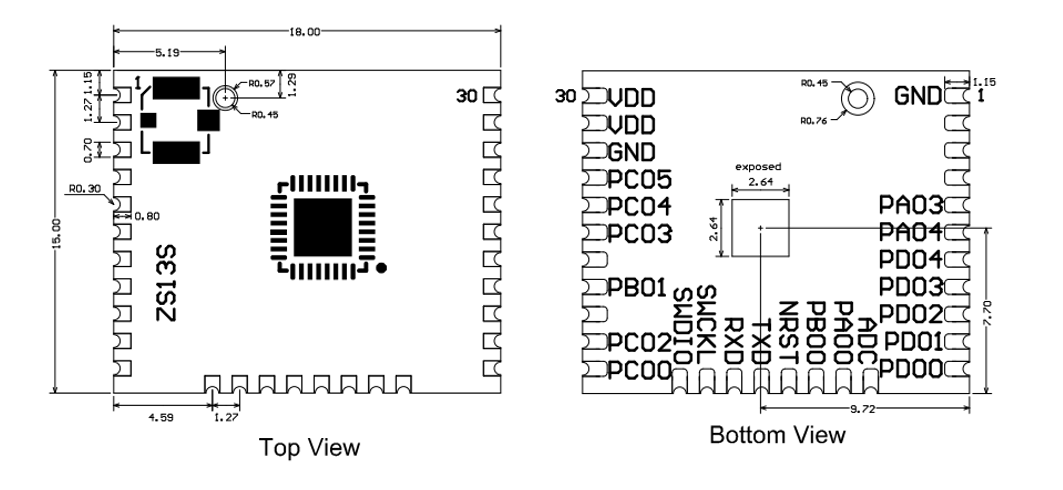
Schematic diagram of footprint
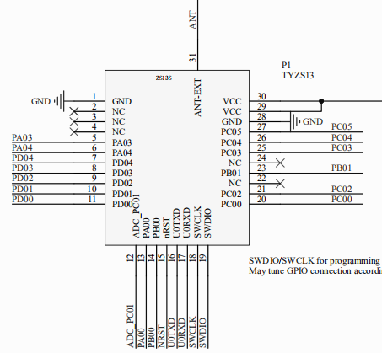
Diagram of PCB footprint-SMT
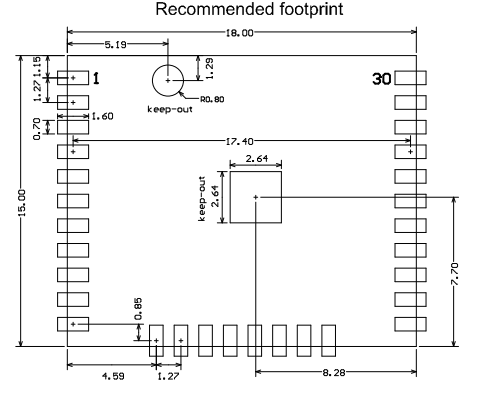
The area indicated as keep-out in the diagram above does not require tinning and should not have any traces routed through it.
Production instructions
-
The Tuya SMT module should be mounted by the SMT device. After being unpacked, it should be soldered within 24 hours. Otherwise, it should be put into the drying cupboard where the RH is not greater than 10%; or it needs to be packaged under vacuum again and the exposure time needs to be recorded (the total exposure time cannot exceed 168 hours).
- SMT devices:
- Mounter
- SPI
- Reflow soldering machine
- Thermal profiler
- Automated optical inspection (AOI) equipment
- Baking devices:
- Cabinet oven
- Anti-electrostatic and heat-resistant trays
- Anti-electrostatic and heat-resistant gloves
- SMT devices:
-
Storage conditions for a delivered module:
-
The moisture-proof bag must be placed in an environment where the temperature is below 40°C and the relative humidity is lower than 90%.
-
The shelf life of a dry-packaged product is 12 months from the date when the product is packaged and sealed.
-
There is a humidity indicator card (HIC) in the packaging bag.
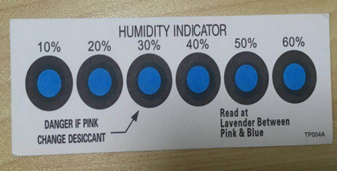
-
-
The module needs to be baked in the following cases:
- The packaging bag is damaged before unpacking.
- There is no HIC in the packaging bag.
- After unpacking, circles of 10% and above on the HIC become pink.
- The total exposure time has lasted for over 168 hours since unpacking.
- More than 12 months have passed since the sealing of the bag.
-
Baking settings:
- Temperature: 40°C and ≤ 5% RH for reel package and 125°C and ≤5% RH for tray package (please use the heat-resistant tray rather than a plastic container)
- Time: 168 hours for reel package and 12 hours for tray package
- Alarm temperature: 50°C for reel package and 135°C for tray package
- Production-ready temperature after natural cooling: < 36°C
- Re-baking situation: If a module remains unused for over 168 hours after being baked, it needs to be baked again.
- If a batch of modules is not baked within 168 hours, do not use the wave soldering to solder them. Because these modules are Level-3 moisture-sensitive devices, they are very likely to get damp when exposed beyond the allowable time. In this case, if they are soldered at high temperatures, it may result in device failure or poor soldering.
-
In the whole production process, take electrostatic discharge (ESD) protective measures.
-
To guarantee the passing rate, it is recommended that you use the SPI and AOI to monitor the quality of solder paste printing and mounting.
Recommended oven temperature curve
Set oven temperatures according to the following temperature curve of reflow soldering. The peak temperature is 245°C.
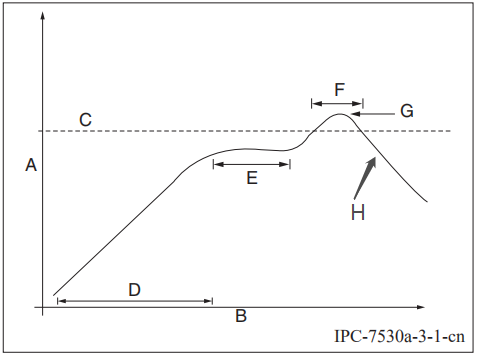
-
A: Temperature axis
-
B: Time axis
-
C: Liquidus temperature: 217 to 220°C
-
D: Ramp-up slope: 1 to 3°C/s
-
E: Duration of constant temperature: 60 to 120s; the range of constant temperature: 150 to 200°C
-
F: Duration above the liquidus: 50 to 70s
-
G: Peak temperature: 235 to 245°C
-
H: Ramp-down slope: 1 to 4°C/s
Note: The above curve is just an example of the solder paste SAC305. For more details about other solder pastes, please refer to Recommended oven temperature curve in the solder paste specifications.
Storage conditions
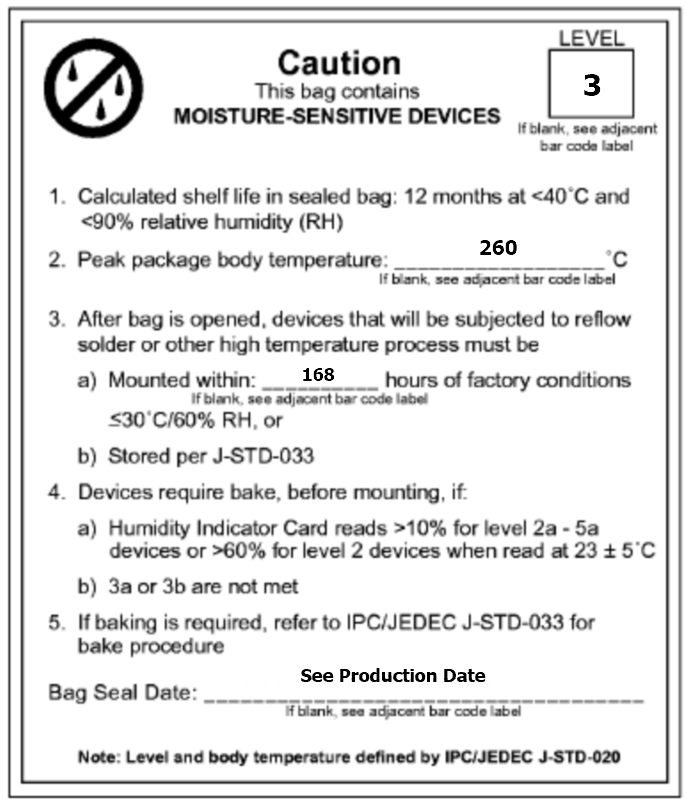
MOQ and packaging information
| Product model | MOQ (pcs) | Packing method | Number of modules per reel | Number of reels per carton |
|---|---|---|---|---|
| ZS13S | 6400 | Tape reel | 1600 | 4 |
Appendix: Statement
FCC Caution: Any changes or modifications not expressly approved by the party responsible for compliance could void the user’s authority to operate this equipment.
This device complies with Part 15 of the FCC Rules. Operation is subject to the following two conditions: (1) This device may not cause harmful interference, and (2) this device must accept any interference received, including interference that may cause undesired operation.
Note: This equipment has been tested and found to comply with the limits for a Class B digital device, pursuant to part 15 of the FCC Rules. These limits are designed to provide reasonable protection against harmful interference in a residential installation. This equipment generates, uses, and can radiate radio frequency energy and, if not installed and used in accordance with the instructions, may cause harmful interference to radio communications. However, there is no guarantee that interference will not occur in a particular installation. If this equipment does cause harmful interference to radio or television reception, which can be determined by turning the equipment off and on, the user is encouraged to try to correct the interference by one or more of the following measures:
- Reorient or relocate the receiving antenna.
- Increase the separation between the equipment and receiver.
- Connect the equipment into an outlet on a circuit different from that to which the receiver is connected.
- Consult the dealer or an experienced radio/TV technician for help.
Radiation Exposure Statement
This equipment complies with FCC radiation exposure limits set forth for an uncontrolled rolled environment. This equipment should be installed and operated with a minimum distance of 20cm between the radiator and your body.
Important Note
This radio module must not be installed to co-locate and operating simultaneously with other radios in the host system except in accordance with FCC multi-transmitter product procedures. Additional testing and equipment authorization may be required to operate simultaneously with other radios.
The availability of some specific channels and/or operational frequency bands are country dependent and are firmware programmed at the factory to match the intended destination. The firmware setting is not accessible by the end-user.
The host product manufacturer is responsible for compliance with any other FCC rules that apply to the host not covered by the modular transmitter grant of certification. The final host product still requires Part 15 Subpart B compliance testing with the modular transmitter installed.
The end-user manual shall include all required regulatory information/warning as shown in this manual, including: This product must be installed and operated with a minimum distance of 20 cm between the radiator and user body.
The RF module is considered as a limited modular transmitter according to FCC rules. Even though the RF module gets an FCC ID, the host product manufacturer can not use the FCC ID on the final product directly. In these circumstances, the host product manufacturer integrator will be responsible for re-evaluating the end product (including the transmitter) and obtaining the FCC authorization by a Class II permissive change application or a new application.
Declaration of Conformity European notice

Hereby, Hangzhou Tuya Information Technology Co., Ltd declares that this module product is in compliance with essential requirements and other relevant provisions of Directive 2014/53/EU,2011/65/EU. A copy of the Declaration of conformity can be found at https://www.tuya.com.

This product must not be disposed of as normal household waste, in accordance with the EU directive for waste electrical and electronic equipment (WEEE-2012/19/EU). Instead, it should be disposed of by returning it to the point of sale, or to a municipal recycling collection point.
The device could be used with a separation distance of 20 cm to the human body.
Is this page helpful?
YesFeedbackIs this page helpful?
YesFeedback

